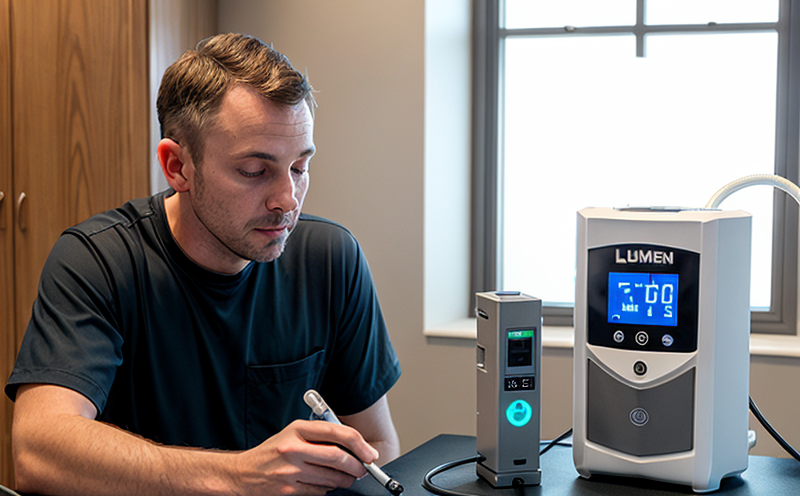EN 62471 Photobiological Lifetime Safety Testing of Light Sources
The EN 62471 series of standards provides a comprehensive approach to ensuring the photobiological safety of light sources. This standard is particularly important for lighting manufacturers and quality managers who must ensure that their products meet stringent safety requirements throughout their lifetime.
EN 62471 covers various aspects including the classification of light sources based on their potential risk, the measurement methods required to determine photobiological safety, and the procedures for conducting these measurements. The standard is designed to protect against harmful effects due to overexposure to ultraviolet (UV), visible, and infrared (IR) radiation.
The testing procedure involves several steps which are critical for ensuring compliance with the standard. These include:
- Identification of the light source
- Determination of the spectral distribution
- Evaluation of the risk level according to EN 62471-2-1 and -2-2
- Measurement using appropriate instrumentation
- Data analysis and interpretation
The testing process is intricate and requires a deep understanding of photobiology, optical measurement techniques, and safety standards. Proper specimen preparation is crucial to ensure accurate results, which includes the correct handling and placement of the light source during testing.
Instrumentation used in these tests typically includes spectroradiometers or integrating spheres with photodiodes capable of measuring UV, visible, and IR radiation. The data collected from these instruments must be analyzed using specific algorithms to determine whether the product meets the safety requirements outlined in EN 62471.
The importance of this testing cannot be overstated, especially given the increasing use of LED lighting technology which can produce significant amounts of UV or IR radiation under certain conditions. Compliance with EN 62471 is not only a legal requirement but also an essential step in maintaining consumer trust and ensuring product safety.
Our laboratory employs state-of-the-art equipment and experienced personnel to conduct these tests rigorously, ensuring that our clients receive accurate and reliable results. By adhering strictly to the procedures outlined in EN 62471-2-1 and -2-2, we guarantee that your products will meet all necessary safety standards.
Understanding the specifics of this standard is key to appreciating its importance for any organization involved with lighting design or manufacturing. Proper implementation ensures not only compliance but also a safer end product, contributing positively to public health and well-being.
Applied Standards
| Standard | Description |
|---|---|
| EN 62471-1:2008 | General requirements for photobiological safety of lamps and lamp systems |
| EN 62471-2-1:2015 | Determination of the photobiological risk classification of light sources - Part 1: Photometric measurement methods for general and directional illumination lamps, lamp systems, luminaires and lighting units |
| EN 62471-2-2:2018 | Determination of the photobiological risk classification of light sources - Part 2: Measurement methods for other light sources (LEDs, OLEDs, VHO lamps) |
Scope and Methodology
The scope of our EN 62471 Photobiological Lifetime Safety Testing service includes the comprehensive evaluation of light sources to ensure they comply with all relevant photobiological safety requirements throughout their operational lifetime. This involves not just a one-time test but an ongoing assessment that considers changes in performance over time.
The methodology we employ follows closely the guidelines set forth by EN 62471, specifically its parts -1-, -2-1, and -2-2, which provide detailed instructions on how to classify light sources based on their potential photobiological risks. Our approach begins with careful identification of the specific characteristics of each light source being tested.
Once identified, we proceed to measure the spectral distribution using advanced optical instruments capable of detecting UV, visible, and IR radiation accurately. This step is crucial as it forms the basis for determining the risk level associated with the light source according to EN 62471 classification criteria.
Data obtained from these measurements are then subjected to rigorous analysis utilizing specialized software tools designed explicitly for this purpose. The aim here is to identify any variations in spectral distribution over time which could indicate a shift towards increased photobiological risk. Such changes might necessitate additional testing or even corrective measures depending on their severity.
A key aspect of our methodology involves continuous monitoring and reporting of test results. This ensures that clients receive up-to-date information about the safety status of their products throughout their lifecycle, allowing for timely adjustments if required. By adhering strictly to EN 62471 guidelines, we ensure that every product passes through a robust quality control process aimed at safeguarding public health.
Our team of experts works closely with clients from various sectors including manufacturing, research and development (R&D), and procurement to tailor our services according to individual needs. Whether you're looking for initial certification or ongoing compliance verification, we offer flexible solutions that fit seamlessly into your workflow.
Customer Impact and Satisfaction
- Ensures compliance with international safety standards (EN 62471)
- Reduces risk of product recalls due to non-compliance issues
- Promotes brand reputation through adherence to high-quality benchmarks
- Aids in meeting regulatory requirements, thereby avoiding penalties and legal actions
- Enhances customer trust by providing evidence of thorough safety checks
- Supports innovation by offering reliable data for product development
- Facilitates smoother operations by eliminating the need for multiple tests across different stages
- Provides peace of mind to both manufacturers and end-users knowing that products meet stringent safety standards





